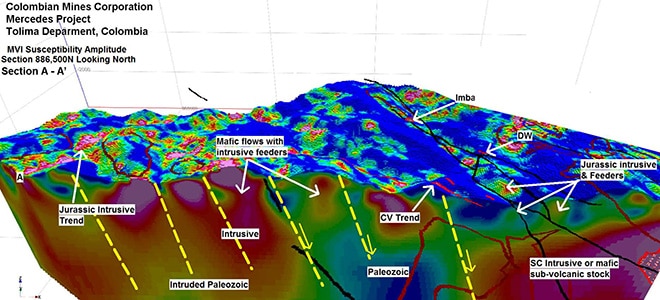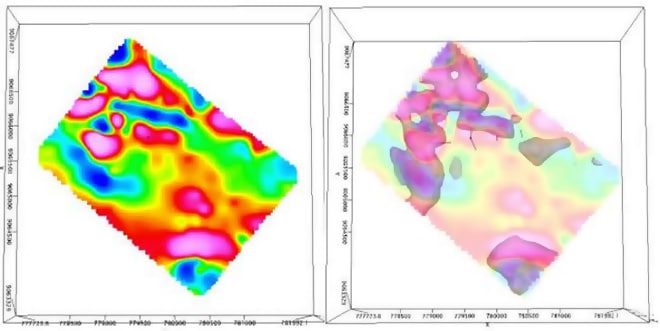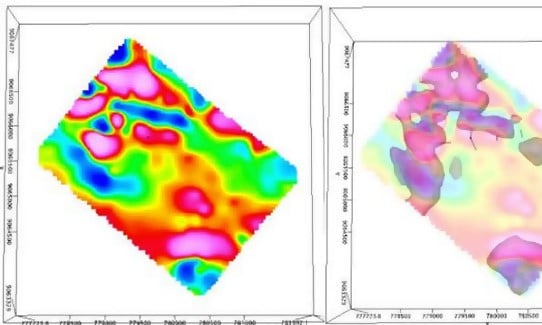Magnetization Vector Inversion (MVI) is proving to be an effective exploration guide for two promising projects in South America.
At the Mercedes project in west-central Colombia, 3D inversion of airborne magnetic data produced an MVI susceptibility model that clearly outlined a major geophysical lineament (the DWI trend) and helped identify 20 highly prospective anomalies within the trend. The project, owned by Vancouver-based Colombian Mines Corporation, covers a large volcano-sedimentary hosted epithermal vein system with outcropping mineralization grading up to 50g/t gold, 1,120g/t silver and 26.5% copper. Consulting geophysicist, Robert Ellis, with EGC Inc. of Reno, Nevada developed the models from the high resolution airborne magnetic and radiometric data collected by MPX Geophysics, the acquisition contractor.

“I have used a lot of magnetic data all over the world, from far northern Canada to the Equator and south, but the use of 3D voxel inversion modelling was an eye opener,” said Robert Carrington, President and CEO of Colombian Mines. “I felt like I had been taken from the Stone Age to the Space Age over a cup of coffee. With these advances, magnetics is no longer the ‘poor country cousin’, but ranks in the same realm as 3D seismics and other high end geophysical exploration tools. Of course the proof will be in the drilling.”
At the Alumbre project in northern Peru, MVI is validating the exploration methodologies chosen by Australian Securities Exchange (ASX) listed explorer Promesa Ltd , which recently pulled a significant copper intercept during its first phase of drilling. The intersection (7 metres @ 0.72% copper) is associated with magnetite highs in the core. The 3D MVI model suggests there is a relationship between a large subsurface volume of rock with a strong magnetic signature and anomalous copper-molybdenum-gold surface and down hole geochemistry, providing further targets for follow up.

Alumbre covers a Cu-Au-Mo porphyry system that has never been systematically explored for porphyry style deposits. Geophysicist Barry Bourne, with Terra Resources Pty Ltd, re-interpreted the company’s historical ground based magnetic data with the MVI methodology to estimate the magnetic susceptibility.
In a recent announcement, Promesa Director, Ananda Kathiravelu said: “This appears to be an entirely new low altitude district with excellent infrastructure and logistical amenities.” The exploration model includes extensive alteration mapping geochemistry, sampling, geophysics and an interpretation of a new magnetic susceptibility 3D model of the project area.
Both companies are planning to follow up their promising MVI interpretations with further drilling. At Mercedes, plans and sections generated through the susceptibility model can be compared with known geology to outline drill targets with greater accuracy. At Alumbre, Promesa will use the model to zero in on higher grade mineralization within the larger Cu-Mo-Au porphyry system. The magnetic susceptibility and geochemistry of the discovery hole indicates that mineralization continues to the north, west and down dip.
Both projects lie at low latitudes, where the low inclination of the Earth’s magnetic field can make magnetic interpretation challenging. Useful in all geological environments, Magnetization Vector Inversion is most effective in situations where geological processes or geophysical effects, such as deformation, anisotropy, remanent magnetization and high susceptibilities, alter magnetization direction.
MVI, part of Geosoft VOXI Earth Modelling, is an effective tool for visualizing the subsurface quickly and accurately because it solves for both the magnitude and direction of rock magnetization, making it more generally applicable than traditional susceptibility modelling.
Sources: Colombian Mines Corporation and Promesa Ltd





